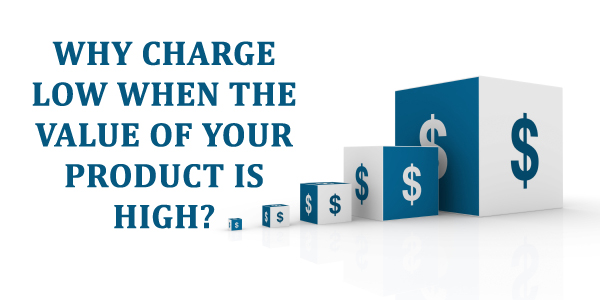VN:F [1.9.22_1171]
Rating: 3.5/5 (2 votes cast)
There’s a general misconception among online sellers—customers love cheap-priced products. When looked broadly, this claim might look quite fitting. But ‘broadly looking’ is also a gateway to make big blunders.
So, when running a business, you must look at things more scrutinizingly, with the practical
application of cause and effect theory. Online shoppers look for low-priced products. But what they
really love and want is high-quality purchase. And in that scenario, they don’t mind shelling few
extra bucks. Of course, come in play, certain exceptions, which we would discuss later.
This slight shift in mindset regarding online pricing is rather imperative for strategy-making, which,
for many vendors, till now, only includes setting products at the cheapest price possible. Why?
Because that’s what customers want!
So, let’s throw this important question to you— how do you price your products? Do you follow the
basic steps that are essential to becoming a profitable e-commerce player?
Admittedly, pricing your products might not look like too much work. You add the profit margin to
the final cost of the product, and that’s that—that’s the final selling price for you. (This strategy is
called cost-based pricing, by the way). Sadly, it isn’t that easy. It’s simple—but definitely not easy.
But worry not, this is why we’re here for! Let’s first get to know about common e-commerce
pricing strategies, and then jump onto which one should you employ.

5 Types of Online Pricing Strategies
I. Cost-based pricing
Discussed already, this is the most common type of pricing strategy, whose secret to popularity lies
in the simplicity. What’s the final cost of your product? What profit do you want to make from your
sales? Add both of these amounts together and you will have a final selling price at-hand.
(Cost + Desired Profit Margin = Selling Price)
At times, this pricing strategy is good enough. However, since not undertaking other factors aside
from your own desired profit, you shouldn’t always go with.
II. Value-based pricing
Why charge low when the value of your product is high? This is the basic underlying idea behind this
strategy. And brands like Apple, Louis Vuitton, and Gucci champion it.
Here, you must focus on the value that your product is offering to the customers. While perfect for
the luxury brands, this pricing strategy can also work decently with essential goods, caeteris paribus.
You need to do thorough market research and customer analysis before going ahead with this
strategy, factoring the value of your product (which would also depend on your branding strategy)
for a particular customer on a given period of time.
For example, if you’re offering an umbrella, people would buy it more in autumn than in winter.
Also, if you’re offering a colorful umbrella that likely costs more than the black-white ones, it might not suit the budget of all consumers. But since it’s raining, will the person buy from you or not,
depends on his budget, urgency in need, as well as your competitors nearby.
Without any doubt, this pricing strategy is quite complex to mechanize. It would require a lot of your
time.
III. Competitor-driven pricing
Here at ChannelSale, we have always been a firm believer that competitors can be a great source to
learn from and be motivated to reach new heights. This is what we say to all new online sellers, who
often feel lost even when with the best multi-channel e-commerce solution.
Back to the topic, competitor-driven pricing is pricing your products according to your competitors’.
You monitor the price at which your direct competitors are selling their products at, and then make
your decisions accordingly.
If they are selling low, you sell low, or lower. If they are selling high, after analyzing their sales
performance, you, too, sell high, or higher. Easy-peasy.
IV. Target-based pricing
This pricing strategy is a darling to startups whose initial focus remains to cross the break-even
point. You set the price of your products according to your long-term target; and by the long-term
target, we mean 9-24 months.
Set a goal for a return on the total cost, and then price your products in whatever way possible.
Offer discounts to few customers and charge others slightly higher, sell to few on loss and to others
in big profit—it doesn’t matter what approach you take. Your ultimate goal is to achieve this target.
V. Time-based pricing
Umbrella, in the aforementioned example, is a seasonal product, whose demand peaks during
monsoon and slumps during winter. So, during rainy days, you can sell your umbrellas at a high
price—people would still buy from you because they require something to protect from the rain.
However, in winter, even when priced low, nobody would buy umbrellas because they don’t require
them.
This is what this time-based pricing strategy entails. Of course, the umbrella is a very evident
example. Other products may not be as evident as to how their price and demand swings with
season/time-change. This calls in for extensive market research and competitive analysis.
Once you’re aware of how prone your products are to time, you can then price them accordingly to
maximize the profit.
These are 5 types of online pricing strategies. Of course, if we get into details, these types branch
out into plenty more personalized, data-driven strategies. If you’re a new online vendor, it’s best
that you start with the basic strategy and then modify it as you go according to your persisting sales
performance and niche trends.
Now coming to the next part of the process – knowing which one of these strategies is ideally
employable for you. Identify the right one is quite easy. It all comes down to what you sell, who you
sell to and what are your goals. Let’s quickly dive into it with 5 crucial tips on online pricing strategy:
5 Tips on Creating an Effective Pricing Strategy
I. Invest in your brand
Apple, for example, can launch a Smartwatch tomorrow and sell it at any price that it desires. And
people would actually buy it. This isn’t an option for other less-known tech companies who might be
offering just as great smartwatches. Why? Because Apple has invested in its brand, others haven’t.
People trust its name. It commands authority in the market.
Imagine if you enjoy a similar power. You would enjoy higher flexibility in pricing. You would be able
to charge less or higher to customers knowing that your target audience will buy only from you
regardless the price because they trust your brand name.
So, right from the get-go, invest heavily in branding. Center your marketing efforts around your
brand name. Let people know who you are, what kind of products you offer and what quality
standards do you follow.
II. Care about your profit margin
There are sellers who obsess about making a good profit. And then there also those who overlook
their profit at the initial stage, hoping that once the sales pickup, they would make up for the lost
profits easily.
This is a very dangerous approach. If you have just started selling online, setting up the business
would have already cost you big. Now, in hope to increase sales, if you start offering the products at
the cheapest price, even if it means compromising on your profits, it could turn to be quite fatal for
the financial health of your business.
So, at any stage of the business, always keep an eye on the profit margin. Always ensure of a
consistent flow of income that’s covering the cost of your initial investment.
III. Don’t compete with successful competitors
Learn from successful competitors, don’t compete with them—this is a simple mantra you should
follow when pricing your products. Because your successful competitors have the room to lower
their price, attract more customers and run you out of the business. To tackle competition from new
entrants like you, they wouldn’t mind taking a hit on their profit margin for the time being.
So, handpick some of the successful names in your industry. And then follow their pricing strategy.
Unless you’re well-established yourself, don’t step-up to compete with them.
IV. Make incentives a big part of the pricing
Whatever pricing strategy you choose, there would always be some room to offer incentives to your
customer—you just need to know when and how to offer them.
Always remember, discounts can trigger online shoppers like no other thing. Adding unique offers to
the customers can significantly boost your retention rate. Going out of your way to incentivize your
existing customer – like offering them free vouchers – can turn them in your brand’s fans, which
could then initiate word-of-mouth marketing. And once people are talking about your brand and
products, there wouldn’t be any stopping to your sales.
V. Have a different strategy for different segments
This is a simple mistake we see many online sellers make—using a single pricing strategy for all the
market segments. And we understand why. With all the hassle and stress online selling brings with
so many backend tasks – like product listing and inventory management – who really have the time
to create unique strategies for different types of the target audience.
Here, you need to do two things: one, sign up to e-commerce software solution that can ease all
your backend activities, leaving you with ample of time; second, once with enough time, go on to
mechanize unique pricing strategies for unique segments. Create a sales funnel, identify where your
prospects are in the funnel, and then have a different set of pricing to help them through the
customer journey. It isn’t as difficult as it sounds, really!
Undertake these 5 crucial tips when pricing your products and it will become evidently clear what
kind of strategy would be an ideal fit for you.
The success of your e-commerce business, in today’s hyper-competitive market, depends largely on
your pricing strategy. Get things correct in this department and you’re good to go.
VN:F [1.9.22_1171]


